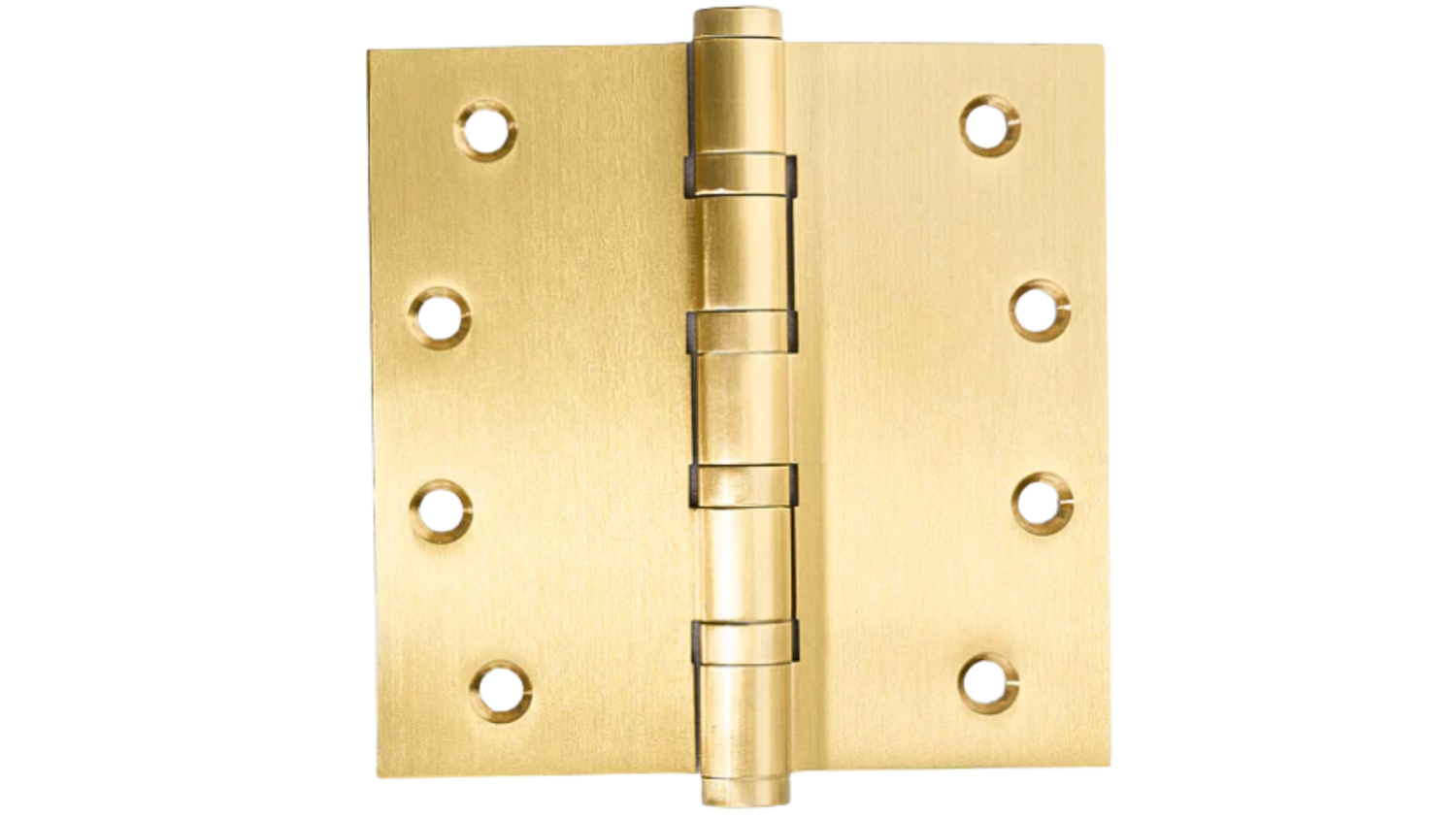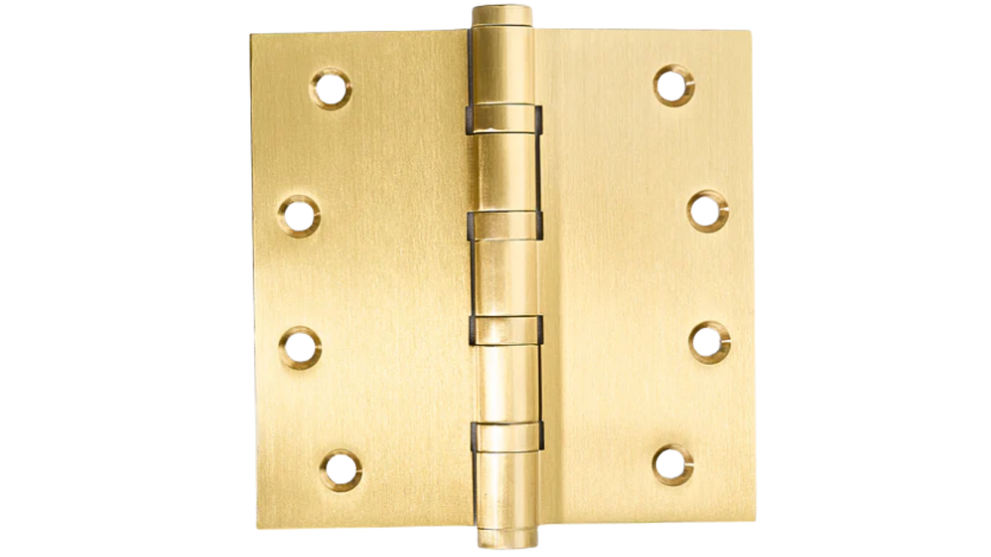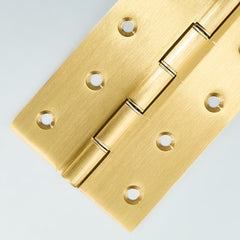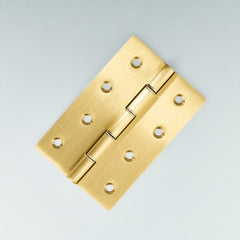Key Takeaways:
- Select The Right Hinge Style For Form & Function: Choosing the right hinge style is crucial for design alignment, daily use, and achieving precise cabinet reveals.
- Understand Your Cabinet Construction Before Installation: Your cabinet foundation, face-frame, or frameless, determines hinge type, placement, and correct installation techniques.
- Fine-Tune Alignment For Smooth, Professional Results: Troubleshoot alignment issues with adjustments and careful handling to ensure perfect door operation and aesthetics.
At Inspire Hardware, we design with intention and precision. Every finish, edge, and weight is calibrated for performance and longevity. Our pieces are refined, born from the hands of craftspeople who believe the smallest detail deserves the greatest care.
Installing cabinet hinges isn’t difficult, but doing it well makes all the difference. From choosing the right hinge style to getting exact alignment, this process shapes how your cabinetry looks and feels. Whether outfitting a new build or refreshing vintage doors, proper technique ensures longevity, clean function, and a polished finish. Little adjustments go a long way, and a pro-level result is absolutely within reach.
This blog will explore the essential tools, hinge types, and installation techniques that ensure your cabinet doors open smoothly, align cleanly, and last for years—without guesswork or frustration.
Essential Steps To Install Cabinet Hinges Yourself
Installing cabinet hinges doesn’t require care, accuracy, and basic techniques. With some planning, you can achieve a clean, precise fit that supports smooth door function. Reviewing a cabinet styles guide can help confirm your hinge placement and overlay strategy for the best possible outcome if you're working with different door profiles.
1. Gather Precision Tools
- Tape measure, combination square, pencil
- Drill/driver with sharp brad-point bits
- Countersink bit, hinge boring bit (35mm for most European concealed hinges)
- Awl, clamps, masking tape, soft cloth
- Screws that match hinge spec and cabinet material
- Painter’s pyramids or blocks to support doors
2. Confirm Hinge Type And Overlay
- Identify frameless vs. face-frame construction
- Determine overlay (full, half, or inset) and door thickness
- Cross-check the manufacturer’s cup distance, bore depth, and screw spacing
3. Map Your Reference Lines
- On the door interior, draw a centerline for each hinge (typically 3–4 inches from top and bottom edges)
- On the cabinet, mark corresponding lines on the side panel or face frame
- Use a combination square to keep lines perfectly square to the edge
4. Bore The Hinge Cups
- Set a depth stop to avoid punching through the door face
- Place painter’s tape as a visual depth guide and to reduce tear-out
- Bore the 35mm cup hole along your centerline, maintaining the setback specified by the hinge (commonly 3–5mm from the door edge)
- Test-fit the hinge cup; it should sit flush without forcing
5. Pre-drill Pilot Holes
- Use an awl to dimple screw locations in the cup and mounting plate areas
- Drill pilot holes sized to your screws and substrate (smaller for MDF to maintain grip)
- Countersink lightly if using flat-head screws to prevent mushrooming
6. Install Hinge Cups On The Door
- Seat the hinge cups into the bores
- Drive screws by hand for final snugging to avoid over-torque and thread stripping
- Ensure both hinges align perfectly along the centerline
7. Mount Plates To The Cabinet
- For frameless: position plates on the side panel per overlay spec; use your reference lines
- For face frame: use the appropriate adapter or plate designed for frames
- Level each plate, clamp if needed, then pre-drill and fasten
8. Hang The Door
- Support the door on blocks to maintain consistent reveals at the bottom
- Clip hinges onto the plates; listen/feel for a clean lock-in
- Check that the door swings freely without scraping
9. Verify Symmetry And Function
- Close the door slowly; watch the reveal at the top, sides, and bottom
- Ensure consistent overlay across the run of cabinets
- Confirm soft-close action (if applicable) and adjust damper settings
10. Lock In The Hardware
- Once satisfied with the reveals, snug all screws again
- Add a touch of beeswax or dry lubricant to screws if you anticipate seasonal wood movement
Troubleshoot Common Alignment Issues In Minutes
When doors don’t sit right, you feel it whenever you open a cabinet. Precision matters, especially when working with high-quality kitchen cabinet hardware meant to perform beautifully and last for years.
Here’s how to diagnose and fix the most common hinge alignment issues quickly, precisely, and without guesswork:
Door Rubbing The Frame On One Side
If the door rubs against the cabinet frame, the most likely cause is that the hinge cup or plate is set too deeply, or the door may have shifted slightly during installation. Loosen the hinge plate screws and adjust the door laterally using the side-to-side screw, usually the front screw on European-style hinges. Use small micro-adjustments and test after each shift. A 2 mm spacer between the door and frame can help ensure a consistent reveal.
Doors Not Level Across The Top
Uneven doors often result from misaligned screw holes or base cabinets that aren’t perfectly level. Begin by adjusting the vertical screw to raise or lower the door. If you hit the adjustment limit, slightly loosen the hinge plate and shift it up or down manually. Use a torpedo level to check alignment at the top rail. If the cabinet is out of level, align the door with the cabinet’s lines, not the floor.
Gapping At The Top Or Bottom Reveal
Uneven gaps typically mean the door is tilted inward or outward. Start with the depth adjustment screw to pull the door in or push it out. Begin with the top hinge, then match the bottom for a flush finish. If gaps persist, slightly loosen both hinge plates, pivot the door into position, and retighten. This fine-tuning helps square the door to the frame for a clean, even look.
Double Doors Colliding In The Center
When double cabinet doors hit in the middle, the side-to-side adjustments are likely overtightened, causing the doors to push inward. Loosen each door’s lateral screw slightly, by about 0.5 to 1 mm, and use a 2–3 mm spacer to maintain a uniform gap during tightening. Also, check soft-close dampers; if they are over-tensioned, they may cause bounce-back and lead to collisions.
Door Springs Open Or Won’t Stay Closed
If a cabinet door doesn’t stay shut or pops open, check for an incorrect hinge overlay or misaligned magnetic catches. Adjust the depth screw so the door sits flush. Ensure magnetic catches are fully aligned with their strike plates. Confirm the hinge overlay matches your cabinet type, as mismatched overlays can force the door open at rest.
Protect Your Finish During Installation And Beyond
When you work with beautifully finished doors and frames, treat them like design elements. Preserve that pristine surface from the first pilot hole to the final alignment.
Stage On A Protected Surface
Always place your cabinet doors face down on a padded, clean surface like a moving blanket or thick craft paper. Avoid using towels, as loose fibers can trap debris and cause scratching when pressure is applied during hinge installation.
Apply Tape With Precision
Use low-tack painter’s tape to protect areas where tools or hands may come in contact, like hinge mortises and door edges. Lightly burnish the tape with a plastic card to seal it, and remove it within 24 hours to prevent residue or “ghosting” on the finish.
Pre-Drill With Care
Use a sharp brad-point bit sized to the screw’s core to prevent splitting and finish damage. Apply a depth stop or wrap painter’s tape around the bit to avoid drilling too deep. Clear wood chips as you go; debris under hinge plates can act like sandpaper over time.
Avoid Contact Between Steel And Finished Surfaces
Lightly magnetize your drill bits to hold screws in place and reduce slipping. Set a low torque level to avoid overdriving or slipping if using a power driver. Always finish screw installation by hand to maintain complete control and protect the hardware’s finish.
Use The Right Screws For Each Step
Start with hardened pilot screws to create clean threads in hardwood without risking breakage. Once the hole is set, switch to your final matching finish screws. This ensures both strength and a consistent visual finish.
Clean Hardware Before Final Installation
Before tightening hinge plates or attaching doors, wipe down the metal surfaces with a microfiber cloth and ammonia-free cleaner. When left in place, fine abrasive dust from drilling can settle on hinge leaves and scratch or etch surfaces.
Maintain And Clean Brass Hinges For Lasting Brilliance
You’ve installed your hinges, aligned them to the millimeter, and dialed in your reveals. Now protect that precision. With brass, maintenance isn’t busywork—it’s stewardship. Follow these steps to keep hinges moving silently and looking luminous.
- Identify The Finish First: Determine if your hinges are lacquered or unlacquered. Use a microfiber cloth and warm water for both. Avoid abrasive powders or ammonia-based cleaners, which can damage the metal or strip protective coatings.
- Dust Weekly To Prevent Build-Up: Use a soft, dry microfiber cloth to lift surface dust. For hard-to-reach areas like leaf edges or screw heads, a small detail brush works best to prevent grit from accumulating in moving parts.
- Spot-Clean Smudges Carefully: Dampen a microfiber cloth with warm water and a drop of pH-neutral soap. Gently wipe away fingerprints, then dry immediately with a clean cloth to avoid leaving water spots on the surface.
- Handle Unlacquered Brass With Care: Expect natural patina over time. To brighten, apply a small amount of non-abrasive brass polish with a cloth. Test on a hidden spot first and polish in straight lines. Keep polish away from nearby surfaces.
- Shield Surrounding Finishes: Use painter’s tape to protect nearby paint or stain when polishing or lubricating. This prevents accidental damage, clouding, or visible residue around the hardware area.
- Control Humidity & Harsh Substances: High humidity accelerates tarnishing. Use exhaust fans in kitchens and bathrooms. Avoid exposing hinges to vinegar, bleach, or acidic cleaners, which can pit the brass and compromise its finish.
Professional Tips For Speed And Consistency On Large Projects
Handling large hardware installation projects requires planning, precision, and repeatable systems. With the proper techniques and mindset, you can work faster without sacrificing accuracy or craftsmanship, especially with premium materials like bronze cabinet hardware, where finish integrity and alignment are key.
Standardize Your Hinge Specification
Choose one hinge type, overlay, and drill pattern per cabinet type. Document everything, model numbers, cup depth, plate height, screw size, and reveal goals on a single spec sheet. Post it at your workstation and refer to it consistently.
Build A Dedicated Jig Set
Use a 35mm cup jig with a positive depth stop and a centerline fence block for repeatability. Make left/right jigs for face-frame and frameless styles. Label clearly to avoid mixing tools or measurements.
Batch Work In Logical Sequences
Group tasks: Mark all doors, bore, and pilot and install them in order. Avoid switching tools between steps. Fewer transitions lead to fewer mistakes and a significant gain in overall install speed.
Use Fixed Story Sticks And Gauges
Ditch the tape measure when possible. Use a wheel gauge or story stick to mark consistent hinge spacing. This avoids cumulative measuring errors, especially across tall doors or full cabinet banks.
Keep A Field Failure Kit Ready
Have extras: hinges, plates, extractors, wax fillers, touch-up pens. One broken screw or stripped hole shouldn’t delay a project. A well-prepped kit keeps momentum and professionalism intact throughout the job.
Final Thoughts
You care about precision, beauty, and longevity, and so do we. When you install cabinet hinges with a methodical eye and a commitment to craft, you shape the daily rhythm of a space. Measure twice, mark cleanly, pre-drill accurately, and test-fit before you commit. Align, adjust, and recheck. These small habits compound into professional results that endure.
If you’re specifying hardware for a client or refining your home, lean on our expertise. At Inspire Hardware, we design solid brass hinges that balance weight, strength, and refined movement, engineered to hold alignment and finish beautifully over time. Need help choosing overlay vs. inset, soft-close vs. traditional, or matching finishes across a whole home or hospitality project? Tap into our one-on-one design support and trade program for tailored guidance, samples, and fast delivery.
When you’re ready, we’ll help you specify the right hinges, coordinate finishes, and confidently bring your vision to life.
Read more:
- Modern Kitchen Ideas: 10 Cabinet Designs for a Fresh Look
- A Step-by-Step Guide to Painting Kitchen Cabinets Like a Pro
- Brass Finishes Explained: Differences Between Antique, Satin, and Polished Brass
Frequently Asked Questions About How To Install Cabinet Hinges
How do I choose the right type of hinge?
Start by identifying your cabinet type, face-frame or frameless, and your style preference. From exposed traditional hinges to soft-close concealed styles, match the hinge to door thickness, overlay, and desired functionality.
What is the difference between concealed and exposed hinges?
Concealed hinges are hidden for a clean look and precise alignment, often with soft-close. Exposed hinges are visible, adding decorative detail. Your choice influences both the visual impact and the door's function.
What tools do I need to install cabinet hinges?
Basic tools include a drill, screwdriver, tape measure, Forstner bit, Vix bit, and painter’s tape. Add a level and awl for accuracy, and use soft pressure when working with solid brass finishes.
How do I measure for new cabinet hinges?
Measure your door overlay and thickness first. Then, determine how many hinges are needed based on the door's size and weight. For concealed hinges, cup position and setback guide proper hinge and plate selection.
How do I remove old cabinet hinges?
To support the door, unscrew the hinge from the door side, then the cabinet. If the hinge is sealed with paint, carefully score around it. Save screws and clean surfaces gently before reinstalling or upgrading your hardware.
How far from the edge should I position cabinet hinges?
Set concealed hinge cups about 21–22 mm from the door edge with 3–5 mm setback. Allow a 1/8" reveal and align leaves for exposed hinges to ensure smooth swing and door fit.







